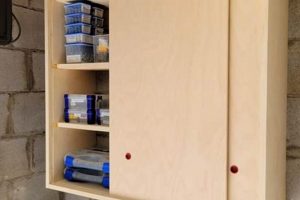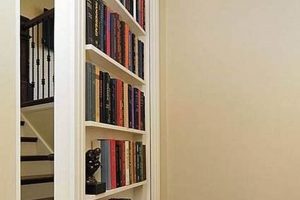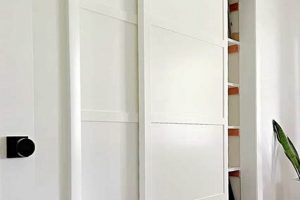A personalized entryway covering, constructed by individuals using readily available materials and tools, provides a functional and decorative surface at a building’s entrance. Such creations can range from simple arrangements of repurposed fabrics to more elaborate woven or painted designs.
The creation of personalized entryway surfaces offers numerous advantages. It allows for cost-effective customization, enabling the tailoring of size, shape, and aesthetic to precisely match individual needs and preferences. Historically, crafting such items represented resourcefulness and a practical application of available materials, reflecting a self-sufficiency ethos.
The following sections will explore various techniques, material options, and design considerations relevant to the fabrication of these personalized entryway coverings. This information will empower readers to create durable and visually appealing additions to their homes or businesses.
Crafting Durable and Aesthetic Entryway Coverings
The successful fabrication of a durable and aesthetically pleasing entryway covering requires careful consideration of materials, construction techniques, and design principles. The following guidelines offer practical advice for ensuring a long-lasting and visually appealing final product.
Tip 1: Material Selection is Paramount: Prioritize durable, weather-resistant materials appropriate for outdoor use. Recycled rubber, treated wood, or resilient synthetic fabrics offer superior longevity compared to less robust alternatives.
Tip 2: Emphasize Secure Construction: Employ robust assembly methods, such as strong adhesives, reinforced stitching, or interlocking designs, to prevent disintegration under heavy foot traffic and adverse weather conditions.
Tip 3: Incorporate Effective Drainage: Implement design features that facilitate water runoff and prevent moisture accumulation. Open weave patterns, raised surfaces, or strategically placed drainage holes contribute to faster drying times.
Tip 4: Consider Anti-Slip Properties: Integrate materials or textures that provide enhanced grip and reduce the risk of slips and falls, particularly in wet conditions. Rubber backing or textured surfaces are effective options.
Tip 5: Design for Cleaning and Maintenance: Select materials and construction techniques that allow for easy cleaning and removal of dirt and debris. Smooth surfaces, removable components, or hose-friendly materials simplify the maintenance process.
Tip 6: Colorfastness is Essential: Opt for materials that resist fading or discoloration from prolonged exposure to sunlight and UV radiation. Colorfast dyes and UV-resistant coatings ensure long-term vibrancy.
Tip 7: Account for Dimensional Stability: Choose materials that exhibit minimal expansion or contraction due to temperature fluctuations, preventing warping or cracking over time.
Adhering to these guidelines ensures the creation of a functional and visually appealing entryway covering that withstands the rigors of daily use and environmental exposure. The resultant product provides a welcoming and practical addition to any entrance.
The subsequent sections will delve into specific design considerations and explore advanced techniques for achieving customized aesthetic effects.
1. Material Durability
The longevity and functionality of a fabricated entryway covering are inextricably linked to the durability of the selected materials. Material choice dictates the item’s resistance to wear, tear, and environmental degradation. Inferior materials necessitate frequent replacement, increasing long-term costs and potentially compromising safety. For instance, an entryway covering constructed from untreated natural fibers will rapidly degrade under exposure to moisture and foot traffic, contrasting sharply with the extended lifespan of one built from recycled rubber or treated synthetic polymers. Therefore, an understanding of material properties is paramount to the successful creation of a lasting and effective entryway feature.
Considerations beyond immediate wear also influence material selection. Exposure to ultraviolet radiation, freeze-thaw cycles, and chemical contaminants (such as road salt) can significantly impact the structural integrity of various substances. For example, a wooden base might require regular sealing and treatment to prevent rot and splintering, whereas a polypropylene option would exhibit superior resistance to such elements. The intended location, anticipated traffic volume, and expected environmental conditions should all inform the selection process. Selecting inherently durable materials reduces maintenance requirements and ensures consistent performance over an extended period.
In conclusion, material durability represents a foundational element in the design and construction of fabricated entryway coverings. Neglecting this aspect leads to premature failure and increased expenditure. Prioritizing durable, weather-resistant materials optimizes the item’s lifespan, minimizes maintenance, and ultimately provides superior value. The selection of appropriate materials addresses immediate performance needs while mitigating the long-term challenges associated with environmental exposure and routine use.
2. Construction Technique
The method by which an entryway covering is assembled directly determines its structural integrity, longevity, and overall performance. A poorly executed construction technique, regardless of material quality, will result in premature failure, rendering the item ineffective and potentially hazardous. Conversely, a well-executed technique maximizes material potential, creating a durable and functional product. Examples include the secure joining of woven fabric strips to prevent unraveling, the proper adhesion of a rubber backing to prevent slippage, or the robust fastening of wooden slats to withstand weight and impact. In each case, the construction technique acts as a critical mediator between material properties and the final product’s utility.
Specific construction techniques vary depending on the materials employed and the desired aesthetic. For fabric-based coverings, weaving, knotting, or stitching techniques may be utilized, each offering distinct textural and structural characteristics. For wooden coverings, joinery methods such as mortise and tenon, dovetail, or screw fastening provide varying degrees of strength and aesthetic appeal. The selection of the appropriate technique requires a thorough understanding of the material properties and the anticipated stresses the item will endure. For example, an entryway covering intended for heavy foot traffic necessitates a more robust construction technique compared to one intended for light use.
In conclusion, construction technique is an indispensable element in the fabrication of personalized entryway coverings. It directly impacts the product’s durability, functionality, and safety. A deliberate and informed selection of construction methods, coupled with meticulous execution, ensures the creation of a lasting and effective addition to any entryway. Neglecting this crucial aspect undermines the entire endeavor, regardless of the quality of materials or design aesthetics. The mastery of appropriate construction techniques is, therefore, essential for successful fabrication.
3. Design Customization
Design customization, as applied to the fabrication of entryway coverings, allows for the tailoring of dimensions, materials, and aesthetics to meet specific needs and preferences. This customization is a key differentiating factor, distinguishing handcrafted items from mass-produced alternatives. The ability to select specific colors, patterns, and textures enables the creation of an entryway covering that complements the architectural style of the building and reflects the occupant’s personal taste. For example, a minimalist home might benefit from a simple geometric design using neutral tones, while a more traditional dwelling could utilize a woven pattern incorporating richer colors and textures. Neglecting design customization leads to a generic and potentially incongruous entryway, diminishing the overall aesthetic appeal of the building.
Furthermore, design customization extends beyond mere aesthetics to encompass functional adaptations. The dimensions of the entryway covering can be precisely tailored to fit the available space, preventing tripping hazards and maximizing coverage. Material selection can be optimized to suit specific environmental conditions; for instance, a home in a snowy region might benefit from a covering constructed from a highly absorbent and slip-resistant material. The inclusion of personalized elements, such as monograms or house numbers, adds a unique touch and enhances the overall sense of arrival. The degree of customization possible significantly elevates the value proposition of a self-made entryway covering compared to its commercially available counterparts.
In summary, design customization is a critical component in the creation of personalized entryway coverings, enabling both aesthetic and functional enhancements. The ability to tailor the item to specific needs and preferences distinguishes it from mass-produced alternatives and allows for the creation of a unique and welcoming entrance. Challenges may arise in translating design concepts into tangible objects, requiring a combination of creativity, technical skill, and attention to detail. However, the resulting entryway covering represents a significant improvement over a generic option, enhancing both the functionality and aesthetic appeal of the building.
4. Weather Resistance
Weather resistance is a critical performance characteristic for any entryway covering, particularly those intended for outdoor use. Exposure to environmental elements dictates the lifespan and functionality of the item. Consequently, understanding and mitigating the effects of weather is paramount in the design and construction phases.
- Material Selection and Degradation
The choice of materials directly impacts the covering’s ability to withstand environmental stressors. Natural fibers such as untreated cotton are susceptible to rot and mildew in humid conditions, while certain plastics can become brittle and crack under prolonged exposure to ultraviolet radiation. Durable, weather-resistant materials like recycled rubber, treated wood, or synthetic polymers offer superior performance and longevity. Understanding the degradation pathways of various materials under specific weather conditions is crucial for informed selection.
- Water Management and Drainage
Effective water management is essential for preventing water accumulation, which can lead to material degradation and the growth of mold and mildew. Designs that incorporate drainage channels or permeable surfaces allow water to readily pass through, reducing the risk of moisture-related damage. The angle of the surface can also influence water runoff, promoting faster drying times and preventing the formation of ice in freezing conditions.
- Temperature Fluctuations and Dimensional Stability
Exposure to extreme temperature fluctuations can cause materials to expand and contract, leading to warping, cracking, or delamination. Materials with low coefficients of thermal expansion are preferred to minimize these effects. Construction techniques that allow for slight material movement can also help to mitigate stress caused by temperature changes. Consideration must also be given to the adhesive properties of any materials used, as extreme temperature variations can impact the bond strength.
- UV Resistance and Colorfastness
Prolonged exposure to ultraviolet (UV) radiation can cause fading, discoloration, and degradation of many materials. Selecting UV-resistant materials or applying UV-protective coatings helps to maintain the item’s aesthetic appearance and structural integrity over time. Dyes and pigments should also be selected for their colorfastness, ensuring that they resist fading or bleeding when exposed to sunlight and moisture.
The interplay of these facets defines the weather resistance of a personalized entryway covering. Careful consideration of materials, design, and construction techniques ensures that the finished product can withstand the rigors of outdoor exposure, maintaining its functionality and aesthetic appeal for an extended period. Ignoring these factors results in premature degradation, increased maintenance requirements, and ultimately, a diminished value proposition.
5. Safety Features
The incorporation of safety features into a fabricated entryway covering directly mitigates the risk of slips, trips, and falls. The absence of such features introduces potential hazards for individuals traversing the entrance. A common example is a covering with a slick surface, which becomes exceedingly dangerous when wet, creating a high probability of slippage. Conversely, an entryway covering constructed with a textured, high-friction surface significantly enhances grip, reducing the likelihood of accidents. The inclusion of features like beveled edges minimizes tripping hazards, especially for individuals with impaired mobility or visual acuity. Therefore, prioritizing safety is not merely an option but a fundamental requirement in the design and fabrication of these items.
Furthermore, the strategic placement of an entryway covering can also contribute to safety. Ensuring the covering is securely anchored or affixed to the underlying surface prevents it from shifting unexpectedly, which could cause a person to lose their balance. Adequate lighting around the entryway is equally important, as it improves visibility and allows individuals to clearly perceive the surface conditions. Material choices also play a vital role; using materials that are resistant to mold and mildew prevents the growth of slippery substances, particularly in humid environments. Regular maintenance, including cleaning and prompt repair of any damages, ensures that the safety features remain effective over time. Integrating these aspects ensures that the fabricated entryway covering actively promotes the safety of those using the entrance.
In summation, the connection between safety features and a fabricated entryway covering is direct and consequential. Thoughtful integration of slip-resistant surfaces, beveled edges, secure anchoring, and appropriate material choices minimizes potential hazards and promotes a safer environment. Prioritizing these aspects is paramount in the fabrication process, ensuring that the finished product serves its intended purpose effectively and without compromising the well-being of individuals using the entrance. Overlooking these safety considerations can lead to preventable accidents and potential liability.
Frequently Asked Questions Regarding Entryway Coverings
The following section addresses common inquiries and concerns surrounding the fabrication and utilization of personalized entryway coverings. These questions aim to clarify misconceptions and provide practical guidance.
Question 1: What is the average lifespan of a constructed entryway covering?
The lifespan of a constructed entryway covering varies significantly based on material selection, construction technique, and environmental exposure. A well-constructed covering, utilizing durable materials and proper drainage, may last for several years. Conversely, a poorly constructed covering, utilizing inferior materials and lacking adequate protection from the elements, may degrade rapidly within a single season.
Question 2: What are the primary considerations for ensuring slip resistance?
Slip resistance is primarily determined by the surface texture and material composition of the covering. Rough or textured surfaces provide increased friction, reducing the likelihood of slippage. Materials such as rubber, coir, and certain synthetic polymers inherently offer greater slip resistance compared to smoother materials like polished wood or smooth plastic. Regular cleaning is also essential to maintain slip resistance by removing accumulated dirt and debris.
Question 3: How does the choice of adhesive impact the durability of multilayered constructions?
The adhesive used in multilayered constructions directly affects the bond strength and overall durability. Selecting an adhesive that is compatible with the chosen materials and resistant to moisture, temperature fluctuations, and UV radiation is crucial. Inadequate adhesion leads to delamination and premature failure of the construction. Specific adhesive recommendations should be based on the specific materials being bonded and the anticipated environmental conditions.
Question 4: What strategies can be employed to prevent fading or discoloration caused by sunlight?
Preventing fading or discoloration requires the use of UV-resistant materials or coatings. Pigments that are inherently resistant to ultraviolet radiation should be selected. Applying a UV-protective sealant or varnish can also provide an additional layer of protection. Regular cleaning to remove surface contaminants can further minimize the impact of sunlight exposure.
Question 5: How does the size and shape of the entryway influence design considerations?
The size and shape of the entryway dictate the optimal dimensions and design of the covering. A large entryway may accommodate a larger covering with a more elaborate design, while a small entryway may necessitate a smaller, simpler design. The shape of the entryway should also be considered to ensure proper fit and coverage. An irregularly shaped entryway may require a custom-cut covering to achieve optimal functionality and aesthetic appeal.
Question 6: What are the potential environmental implications of different material choices?
Different material choices carry varying environmental implications. Utilizing recycled or reclaimed materials reduces the demand for virgin resources and minimizes waste. Selecting sustainably harvested wood or using biodegradable fibers can further reduce the environmental footprint. Conversely, using non-biodegradable plastics or materials that release harmful chemicals during production or disposal can have negative environmental consequences. A comprehensive assessment of the environmental impact should be a key consideration during material selection.
Careful consideration of these questions contributes to the creation of a functional, durable, and aesthetically pleasing entryway feature. Understanding these considerations empowers readers to make informed decisions throughout the fabrication process.
The following section provides concluding remarks summarizing the key concepts presented within this document.
Conclusion
The preceding analysis explored various facets of the creation and utilization of personalized entryway coverings. Key points encompassed material durability, construction techniques, design customization, weather resistance, and safety features. A thorough comprehension of these aspects is essential for producing functional and aesthetically pleasing additions to building entrances. Neglecting any of these elements compromises the overall effectiveness and longevity of the fabricated item.
The capacity to personalize and adapt entryway coverings remains a valuable asset. Individuals are encouraged to apply the presented information to create practical and visually appealing entryway solutions. The informed application of these principles yields a durable and secure component within the built environment.







